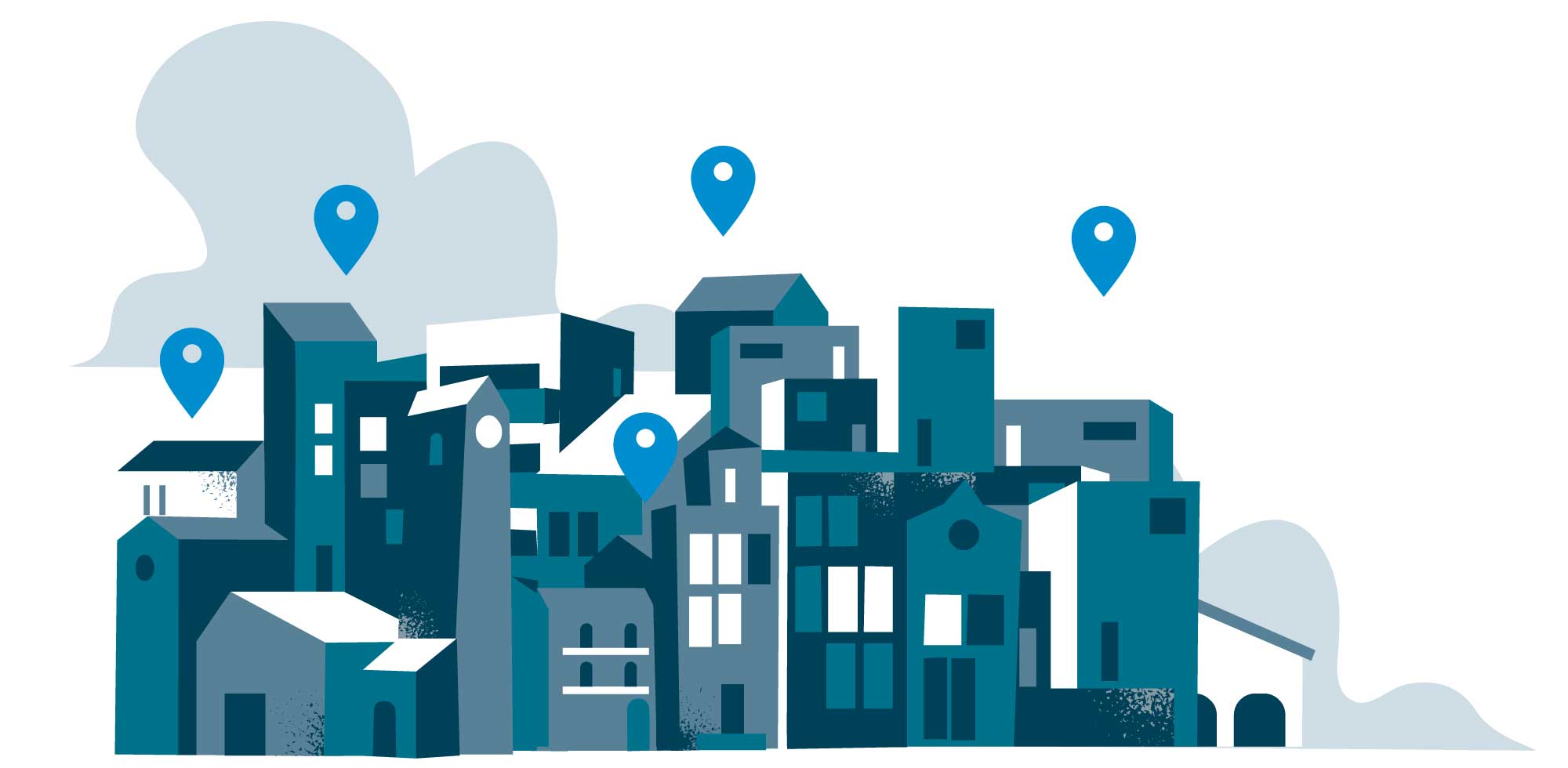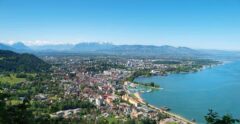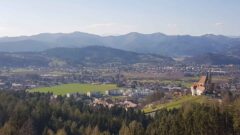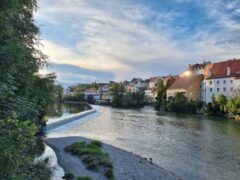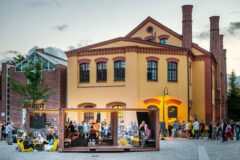A number of small and medium-sized Austrian towns and cities (with 10,000–50,000 inhabitants) have set themselves the objective of becoming climate neutral as quickly as possible and are busy devising appropriate strategies and measures to this end. The Climate and Energy Fund is currently helping 38 of them to formulate roadmaps for achieving climate neutrality as well as strategies and solutions tailored to their various target groups. These towns and cities are able to share experiences and knowledge with others in the same position, leverage synergy effects and draw on findings from research and trial projects in the larger pioneering cities.
BREGENZ
Setting a course for climate neutrality together
As an e5 city,1 Bregenz – the capital of Vorarlberg – has been putting successful climate protection measures in place for some years now. 2023 saw the launch of an intensive participatory process to establish a roadmap for achieving climate neutrality that involved locals, Bregenz’s Climate Advisory Board, business leaders and local associations, organisations and property management companies. One initial outcome of this was a provisional database containing 170 specific measures. In July 2024, the target of becoming climate neutral by 2040 was approved unanimously by the city council and the next steps were agreed. “First of all, the Climate Advisory Board, an independent body of experts, will choose measures from the database to be put into action in the coming year,” explains Gerold Ender, head of the Climate Protection, Environment and Energy Department in the city. “The e5 team (made up of senior administrators, city councillors and the mayor), who are responsible for energy policy work, will then check whether there are enough funds and staff available to implement the proposals, finalise the timetable, instigate the budgeting process and start getting the measures implemented.” There are also plans to monitor the measures to indicate what impact they are actually having.
1 www.e5-gemeinden.at
Getting new stakeholders on board
The city is constantly seeking to bring more stakeholders into the fold. For example, it is working with religious communities that have already voted to pursue energy self-sufficiency and are demonstrating a strong commitment to embracing climate neutrality measures for energy and buildings, amongst other things.
Mobility
Bregenz has been making good progress on transport policy for some years now. Motorised individual transport (MIT) makes up 35% of its total traffic volume, with cycling at 27%, walking at 23% and public transport at 15%. “However, another push is needed to prevent efforts from running out of steam,” Ender says. “We want to motivate the remaining third of people to use our full range of mobility options.”
Focusing on Space heating
The issue of space heating is a major challenge. Fossil fuels (mainly natural gas) provide 85% of the energy required for heating. Work is currently under way to construct a new biomass plant that is set to heat some 500 buildings on the outskirts of Bregenz in the future. The district heating project in the Weidach area of the city is being implemented by the municipal utilities company, the energy supplier Illwerke and the municipality of Wolfurt. Another project involves using water from Lake Constance, heat pumps and free-cooling technology to supply heat and cooling to Bregenz’s new indoor swimming pool, its concert hall and parts of the city centre. A comprehensive heating plan is also being devised together with the municipal utilities company, the Climate Advisory Board and Vorarlberg’s provincial government.
GRATWEIN-STRASSENGEL
Towards a climate-neutral future
Gratwein-Straßengel is one of the largest municipalities in Styria, with four districts – a mix of rural and urban – home to nearly 13,000 inhabitants. Gratwein-Straßengel is a member of the “Grat²”1 climate and energy model region1 and has already implemented some mobility and climate protection projects in the past. Now one of Austria’s pioneering towns, the municipality is currently working on a joint roadmap for climate policy complete with objectives, needs analyses and tangible measures. Officials were quick to realise that more staff would be needed for planning and implementation, and so the municipality created a dedicated “Sustainability Unit” early on. Climate neutrality as understood by the “pioneering cities” project encompasses urban districts, buildings, mobility and energy.
1 www.gratquadrat.at
The municipality is focusing on sustainable renovation and on enhancing existing neighbourhoods in the interests of climate-active residential development. A project application for planning a climate-neutral education and training campus, which includes expanding and upgrading an existing primary school to a twelve-class all-day school, is currently being prepared. This also involves looking at nearby municipal buildings from an energy technology perspective and exploring opportunities for ecological restoration and depaving. “We’re only just getting started, of course, but there’s a lot going on, such as in the area of energy,” reports mayor Doris Dirnberger. “We’ve already got three private energy communities here and are considering setting one up as a municipality as well.” The guiding principle as far as mobility is concerned is “avoiding, shifting, improving”. Key starting points in this area are installing traffic-calming measures and promoting walking, cycling, e-mobility and a multimodal approach to mobility.
STEYR
Targeting climate neutrality by 2040
Steyr city council approved a roadmap for achieving climate neutrality back in July this year. Its vision, its strategy and numerous specific measures for becoming climate-neutral by 2040 were devised in a participatory process involving stakeholders from the worlds of politics, administration and business alongside the general public and civil-society organisations. This process was supported by PlanSinn and the engineering office e7, which also calculated an initial footprint for the city based on its latest energy consumption data. Steyr views climate neutrality as an interdisciplinary topic that must be embedded in every department of the city council. Amongst other things, four moderated workshops have been held and an extensive toolkit of measures has been devised that the various specialist departments will be able to draw on in the future. A RE-START grant from the Public Employment Service (AMS) has enabled additional staff to be taken on. One new employee has been recruited to handle coordination as well as internal and external communication about the city’s bid to be climate-neutral by 2040.
Seizing opportunities
Steyr is making active use of various funding opportunities so that it can deliver its ambitious projects at pace. To convert its bus routes to electricity, for instance, the city obtained a grant from the federal government’s “Zero-Emission Buses and Infrastructure” (EBIN) programme.2 This support is expected to enable a total of eleven electric buses (half of the present fleet) to be purchased and the necessary charging infrastructure installed this year and next. The city has also launched a project to decarbonise its municipal vehicle fleet and has successfully secured an ENIN grant3 for this purpose. This will allow light goods vehicles, emergency vehicles and other municipal service vehicles to be replaced by their electric counterparts. “We’re lucky to have a Finance Director who’s always on the lookout for sources of funding,” reveals Katrin Auer, the city councillor responsible for environmental protection. “For example, this enabled us to switch all the public lighting in Steyr to LEDs with support from the federal government’s municipal investment programme (KIP). Another major project is a feasibility study for geothermal energy. This is a further area we’re actively involved in.”
2 www.ffg.at/EBIN
3 www.ffg.at/ENIN
